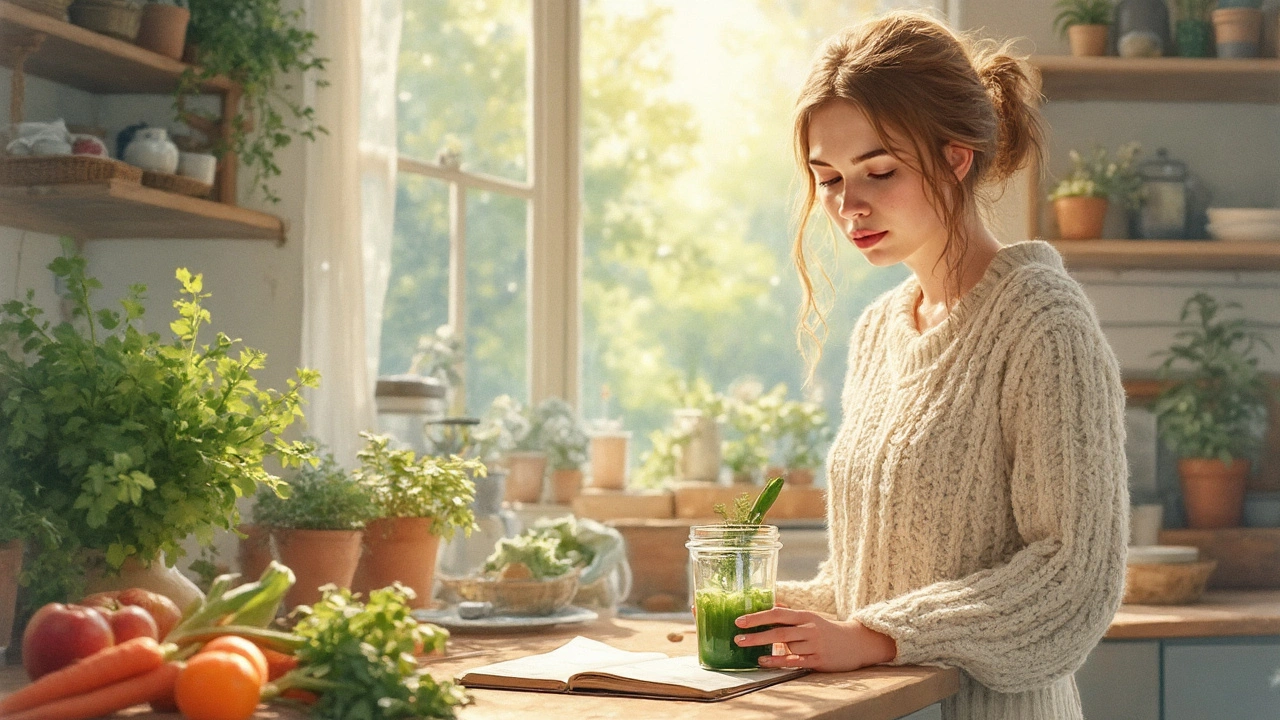Ever watched someone at a café order a bright green juice full of spinach and celery and wondered if there’s real magic in that glass? Let’s face it—health juices are everywhere, lined up pretty in fridges and popping up on social feeds like a badge of wellness. But are they as incredible for your health as people tend to believe, or is there a bit of clever marketing at play? With more Australians reaching for the juice bottle at breakfast or as an afternoon pick-me-up, understanding where health juice fits into a balanced diet feels more important than ever. Some people replace whole foods with juice, hoping for a quick wellness fix, but our bodies aren’t fooled by a colourful drink. It’s time to peel back the label and really see what’s inside that glass.
The Real Nutritional Value of Health Juices
It’s easy to get swept up in the wellness wave, especially when health juice makers throw around words like ‘detox’ and ‘boost.’ But what’s actually in these juices? Most commercial juices are squeezed from fruits and vegetables that, when eaten whole, are powerhouses of fibre, vitamins, and minerals. Take orange juice, for instance: it’s loaded with vitamin C and potassium. But once you turn those oranges into juice, you lose almost all the fibre. That’s huge, because fibre not only fills you up but also helps control blood sugar and keeps your digestion on track. Now, don’t get me wrong, juices aren’t bad—they’re just missing what whole produce has in spades.
Cold-pressed juices, made by crushing and pressing fruits and veggies without heat, are said to protect nutrients better than pasteurised versions. Their vitamin and enzyme levels can be higher right after juicing, but that freshness fades fast. Store-bought juices—especially the ones that last for weeks—are often pasteurised, which helps prevent bacteria but lowers the levels of vitamins like C and some B vitamins.
Look closely at the nutrition panels: fruit-based juices tend to be high in natural sugars; some green juices mix in apple juice so they taste less like a garden and more like lollies. Drinking juice too quickly spikes your blood sugar compared to eating the whole fruit. This may lead you to feel hungry sooner, making it hard to resist snacks later in the day. Some people swear by mixing veggies and fruit for flavour, while others prefer pure veg juices for less sugar. For example, a blend of cucumber, celery, and lemon offers a refreshing low-calorie choice, but might not win any taste awards with everyone.
Want a quick look at how the nutrition stacks up? Here’s a snapshot straight from credible nutrition databases—check out the table below.
| Type | Serving Size | Calories | Sugar (g) | Vitamin C (mg) | Fibre (g) |
|---|---|---|---|---|---|
| Orange Juice | 240ml | 112 | 20.8 | 124 | 0.5 |
| Whole Orange | 1 medium | 62 | 12.2 | 70 | 3.1 |
| Green Veg Juice | 240ml | 42 | 7 | 23 | 0.7 |
| Apple Juice | 240ml | 114 | 23.9 | 2.2 | 0.5 |
| Whole Apple | 1 medium | 95 | 19 | 8.4 | 4.4 |
See the gap? The juice packs in sugar and calories, but whole fruit gives you that all-important fibre on top. That’s why nutritionists like Dr. Joanna McMillan often remind us:
“Juice can be a part of a healthy diet, but it should never take the place of whole fruits and vegetables.”
How Health Juice Fits in a Balanced Diet
So, should you toss those bottles or can juice stick around? Health juice can absolutely play a positive role—if you know where to draw the line. A truly balanced diet means you’re getting enough vitamins, minerals, protein, good fats, and—yes—enough carbs and sugars, but in the right amounts. Juices can help top you up on vitamins, especially if you struggle to fit enough fresh produce into your day. For example, people who live with digestive issues sometimes find raw veggies hard on the gut; juices give their bodies a break while still delivering nutrients.
But for the average Aussie, relying too much on juice can actually unbalance things. Think of juice as that little extra on the side, not the main show. Stick to no more than one small glass (125-150ml) a day for adults, per the Australian Dietary Guidelines. It’s also smarter to go for juices that are mostly vegetable, since these keep your sugar intake down and your vitamins up. Juice blends that feature beetroot, carrots, spinach, or kale alongside lemon or ginger offer a savoury, antioxidant-rich option without tipping the sugar scale.
What about juicing at home? Home juicers skip the additives and let you control every ingredient—no added sugars, no mysterious ‘flavourings’, and you can toss in fibre-rich ingredients if your juicer lets you. Try adding a thumb of fresh ginger for anti-inflammatory benefits, or a squeeze of lemon for Vitamin C. There’s nothing like waking up with a glass of chilled carrot and orange juice—made fresh by your own hands.
If your main goal is to boost your nutrition, don’t ignore the value of what’s left behind in your juicer: the pulp. Stir it into muffins, blend into smoothies, or add to soups to catch that fibre most juicers leave out. This way, you’re getting the best of both worlds—a nutrient hit from the juice, and a fibre boost from the byproducts.
Balance, then, comes from moderation and smart choices. Let health juice be a treat or a tool—not a crutch. If you’re reaching for juice often, ask yourself: when was my last whole fruit or veg? Swapping even half your scheduled juices for a snack of carrot sticks or a crunchy apple can keep your diet truly balanced.

Popular Juice Combos and What They Really Do
Walk into any juice bar and you’ll find creative blends. Beetroot and apple, celery and cucumber, watermelon and mint. But what are these combos really doing for you? Some have legit benefits that go beyond Instagram likes.
Let’s take beetroot juice. It’s famous in the sports world—Aussie athletes drink it before running or cycling. Why? Beetroot’s nitrates help open up blood vessels, boosting oxygen flow. Studies led by the Australian Institute of Sport have found that drinking beetroot juice before a workout can improve endurance and boost recovery times. That’s not hype—real research backs it up.
Then there’s carrot and ginger. Beyond the sweet earthy flavour, carrots are rich in beta-carotene, which keeps your eyes in top shape. Ginger, meanwhile, is a go-to for calming upset stomachs or fighting off winter sniffles. Their combo in a juice not only tastes refreshing, it’s a quick immune-system back-up.
Green juices—spinach, kale, cucumber, lemon—promise detox and energy. There’s no evidence that juices “detox” your liver or flush out toxins beyond what your liver and kidneys already do. But getting an extra dose of folate, iron, magnesium, and Vitamin K from leafy greens never hurts. Lemon adds Vitamin C and cuts through the ‘green’ taste, making it easier for folks to enjoy their veggies in a drink.
Don’t forget the fruit-forward blends: apple with mint, mango with orange, pineapple with ginger. They deliver antioxidants and hydration, but the sugar content can creep up fast. If you’re watching your blood sugar or weight, it’s smart to use fruit more as a flavour lift than the main ingredient.
If you’re experimenting at home, here’s a tip: mix veggies as your base, and add just one piece of fruit. Herbs like mint, parsley, or basil can transform the flavour with fewer calories. For something creamy, blend in a splash of coconut water or a chunk of avocado. Keep a juice recipe journal—note how you feel after each combo. Sometimes, tweaking one ingredient makes the difference between an energy boost and a sugar crash.
Here’s a quick guide for tweaking taste and cutting sugar without losing nutrition:
- Start with at least 70% veggies (cucumber, celery, zucchini, leafy greens).
- Add a squeeze of lemon or lime to sharpen the flavour.
- Drop in a little fresh ginger or turmeric for a potent anti-inflammatory kick.
- Use green apples instead of red for less sugar and a tart bite.
- If you need sweetness, go for berries—they offer antioxidants with less sugar than tropical fruits.
Blending, rather than juicing, lets you keep the fibre but gives a thicker texture. If you crave a refreshing drink that fills you up, smoothies might be your friend. If it’s pure refreshment (especially after a steamy Queensland summer run), juice is a tasty way to rehydrate with a vitamin bonus—but treat it as an addition, not a replacement.
Tips for Choosing and Enjoying the Best Health Juices
Ready to grab a juice? Slow down and check the label before you reach for that bottle. Some ‘healthy’ juices pack more sugar than a can of soft drink! Here’s how you can pick smarter and get the best out of your drink.
- Look for 100% juice, no added sugar: If sugar is listed before fruit or veggies, it’s closer to lolly water than a real health drink.
- Short shelf life usually means fewer preservatives and more fresh nutrients. If a juice can live in your fridge for a month, think about what’s keeping it so fresh.
- Veggie-heavy blends offer less sugar and more vitamins. If green juice isn’t your favourite, mix with a little apple or pineapple but keep fruit to a minimum.
- Watch serving sizes—just because the bottle says ‘healthy’ doesn’t mean you should drink it all in one go. Split it with a mate or save half for later.
- Go local and seasonal. Brisbane’s markets are full of fresh produce, and juice bars here often press juices daily from Queensland-grown fruits and greens. Freshness means better taste and more nutrition.
- If you make juice at home, experiment with herbs and spices. Parsley, coriander, or even a touch of black pepper can ramp up antioxidants and make your juice less predictable.
If you live with a health condition like diabetes or kidney issues, talk to your doctor or dietitian before adding juices to your routine. The sugar spikes from liquid fruit hit quickly and can mess with your blood sugar in ways eating whole fruit won’t. Some kidney conditions also mean you need to watch potassium levels, which soar in some citrus and leafy green juices.
For everyone else, think of juice as the sidekick in your diet, not the hero. Always drink juice slowly—preferably with a meal. This curbs blood sugar rushes and helps your body process all those vitamins in a way that feels natural, not abrupt. If you’re on a tight budget, consider blending instead of juicing: less waste, more fibre.
Health juices can be a tasty tool in your balanced diet arsenal, especially when you know the facts lurking under those colourful labels. Whether you’re grabbing a bottle on the way to work, trying a wild new blend at the market, or juicing up a storm at home, making those choices with your real needs in mind—not just clever marketing—puts you in control.







